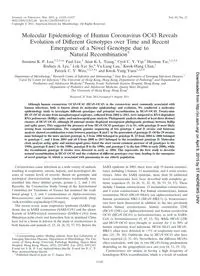
2011 Molecular Epidemiology of Human Coronavirus OC43 Reveals Evolution of Different Genotypes over Time and Recent Emer PDF
Preview 2011 Molecular Epidemiology of Human Coronavirus OC43 Reveals Evolution of Different Genotypes over Time and Recent Emer
JOURNAL OF VIROLOGY, Nov. 2011, p. 11325–11337 Vol. 85, No. 21 0022-538X/11/$12.00 doi:10.1128/JVI.05512-11 Copyright © 2011, American Society for Microbiology. All Rights Reserved. Molecular Epidemiology of Human Coronavirus OC43 Reveals Evolution of Different Genotypes over Time and Recent Emergence of a Novel Genotype due to Natural Recombination� Susanna K. P. Lau,1,2,3,4* Paul Lee,1 Alan K. L. Tsang,1 Cyril C. Y. Yip,1 Herman Tse,1,2,3,4 Rodney A. Lee,5 Lok-Yee So,6 Yu-Lung Lau,7 Kwok-Hung Chan,1 Patrick C. Y. Woo,1,2,3,4* and Kwok-Yung Yuen1,2,3,4 Department of Microbiology,1 Research Centre of Infection and Immunology,2 State Key Laboratory of Emerging Infectious Diseases,3 Carol Yu Centre for Infection,4 The University of Hong Kong, Hong Kong; Department of Pathology5 and Department of Paediatrics and Adolescent Medicine,6 Pamela Youde Nethersole Eastern Hospital, Hong Kong; and Department of Pediatrics and Adolescent Medicine, Queen Mary Hospital, The University of Hong Kong, Hong Kong7 Received 25 June 2011/Accepted 8 August 2011 Although human coronavirus OC43-OC43 (HCoV-OC43) is the coronavirus most commonly associated with human infections, little is known about its molecular epidemiology and evolution. We conducted a molecular epidemiology study to investigate different genotypes and potential recombination in HCoV-OC43. Twenty-nine HCoV-OC43 strains from nasopharyngeal aspirates, collected from 2004 to 2011, were subjected to RNA-dependent RNA polymerase (RdRp), spike, and nucleocapsid gene analysis. Phylogenetic analysis showed at least three distinct clusters of HCoV-OC43, although 10 unusual strains displayed incongruent phylogenetic positions between RdRp and spike genes. This suggested the presence of four HCoV-OC43 genotypes (A to D), with genotype D most likely arising from recombination. The complete genome sequencing of two genotype C and D strains and bootscan analysis showed recombination events between genotypes B and C in the generation of genotype D. Of the 29 strains, none belonged to the more ancient genotype A, 5 from 2004 belonged to genotype B, 15 from 2004 to 2006 belonged to genotype C, and 1 from 2004 and all 8 from 2008 to 2011 belonged to the recombinant genotype D. Molecular clock analysis using spike and nucleocapsid genes dated the most recent common ancestor of all genotypes to the 1950s, genotype B and C to the 1980s, genotype B to the 1990s, and genotype C to the late 1990s to early 2000s, while the recombinant genotype D strains were detected as early as 2004. This represents the first study to describe natural recombination in HCoV-OC43 and the evolution of different genotypes over time, leading to the emergence of novel genotype D, which is associated with pneumonia in our elderly population. Coronaviruses cause infections in a wide variety of animals, resulting in respiratory, enteric, hepatic, and neurological dis- eases of various levels of severity. Based on genotypic and serological characterization, coronaviruses traditionally were classified into three distinct groups, groups 1, 2, and 3 (4). Recently, the Coronavirus Study Group of the International Committee for Taxonomy of Viruses has renamed the tradi- tional group 1, 2, and 3 coronaviruses as Alphacoronavirus, Betacoronavirus, and Gammacoronavirus, respectively (http: //talk.ictvonline.org/media/p/1230.aspx). The recent severe acute respiratory syndrome (SARS) epi- demic due to SARS coronavirus (SARS-CoV) and the identi- fication of SARS-related coronaviruses (SARSr-CoVs) from Himalayan palm civets and horseshoe bats in mainland China have led to a boost in interest in the study of coronaviruses in both humans and animals (5, 13, 24, 26, 33, 37, 55). Before the SARS epidemic in 2003, there were only 19 known coronavi- ruses, including 2 human, 13 mammalian, and 4 avian corona- viruses. After the SARS epidemic, more than 20 additional novel coronaviruses have been described with complete ge- nome sequences (9, 24–26, 31, 42, 45, 50, 53, 54, 57). These include 3 human coronaviruses, 15 mammalian coronaviruses, and 4 avian coronaviruses. For human coronaviruses, human coronavirus NL63 (HCoV-NL63) (an alphacoronavirus) and human coronavirus HKU1 (HCoV-HKU1) (a betacoronavi- rus) have been discovered in addition to the two previously known human coronaviruses, human coronavirus 229E (HCoV-229E) (an alphacoronavirus) and human coronavirus OC43 (HCoV-OC43) (a betacoronavirus), as well as SARS- CoV (a betacoronavirus) (9, 45, 53, 56). While HCoV-229E and HCoV-OC43 were thought to account for 5 to 30% of human respiratory tract infections, HCoV-NL63 and HCoV- HKU1 often were detected in �5% of respiratory tract sam- ples (23, 29, 38). Outbreaks due to HCoV-OC43 also have been reported (3, 32, 44). Nevertheless, the different HCoVs often cocirculate, with one or two HCoVs being predominant depending on the geographical area and year (8, 11, 19, 23). Coronaviruses are unique in having a high frequency of homologous RNA recombination, which is a result of random * Corresponding author. Mailing address: State Key Laboratory of Emerging Infectious Diseases, Department of Microbiology, The Uni- versity of Hong Kong, University Pathology Building, Queen Mary Hospital, Hong Kong. Phone: (852) 22554892. Fax: (852) 28551241. E-mail for S. K. P. Lau:
